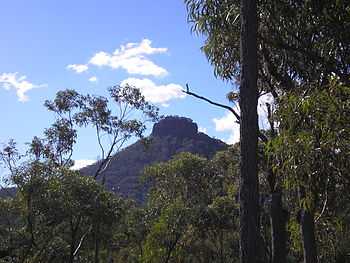Pigeon House Mountain
| Pigeon House Mountain | |
|---|---|
| Aboriginal: Didthul[1] | |
 Pigeon House Mountain | |
| Elevation | 720 m (2,362 ft)[2] |
| Location | |
 Pigeon House Mountain | |
| Range | Budawang Range |
| Coordinates | 35°20′57.44″S 150°15′53.94″E / 35.3492889°S 150.2649833°ECoordinates: 35°20′57.44″S 150°15′53.94″E / 35.3492889°S 150.2649833°E |
Pigeon House Mountain (Aboriginal: Didthul[1]) is a mountain at an elevation of 720 metres (2,360 ft) AHD [2] on the Budawang Range that is situated within the Morton National Park,[1] located on the South Coast region of New South Wales, Australia.
The prominent remnant of a two tier sandstone structure, the nearest town is Milton. Pigeon House Mountain is a popular walking destination, taking an average of three to four hours for a complete ascent and descent from the car park.
Pigeon House Mountain is home to Eastern Grey Kangaroos and Superb Lyrebirds.
Etymology
The mountain was named by Captain James Cook during his voyage of discovery along Australia's eastern coast in 1770.[1]
The Aboriginal name for the mountain is Didthul (or Didhol[2] or Dithol[citation needed]) which means "woman's breast" on account of the distinctive shape of the mountain.[2]
Gallery
-

The summit
-
View from the summit
-
As seen from Mount Budawang, (Pigeon House on right horizon
-
The rare Pigeon House Ash on Pigeon House Mountain
See also
References
- ↑ 1.0 1.1 1.2 1.3 "Pigeon House Mountain". Geographical Names Register (GNR) of NSW. Geographical Names Board of New South Wales. Retrieved 9 October 2013.
- ↑ 2.0 2.1 2.2 2.3 "Didhol (Pigeon House Mountain)". South Coast of NSW. Morningside web publishers. Retrieved 9 October 2013.
| |||||||||||||||||||||||


